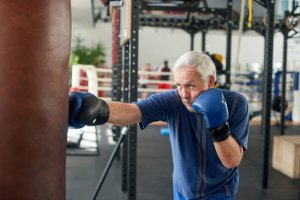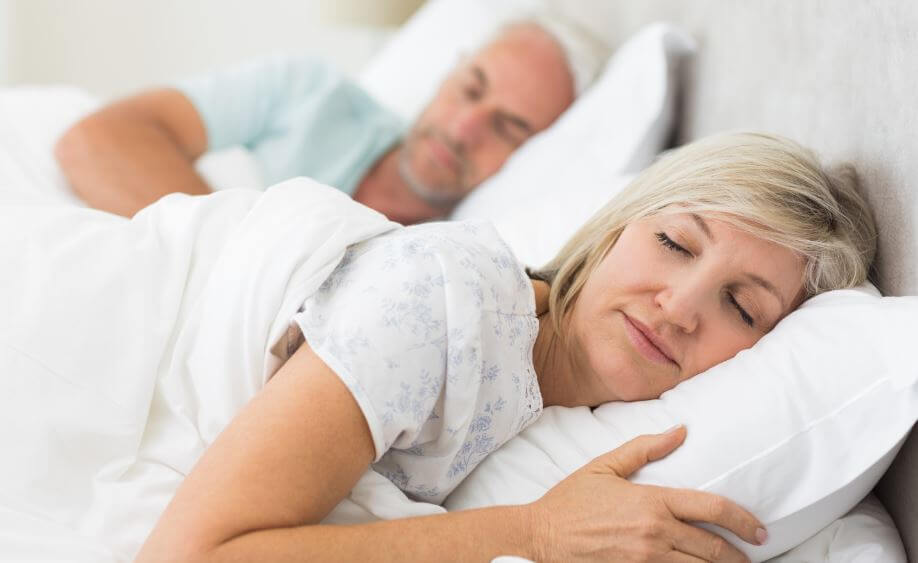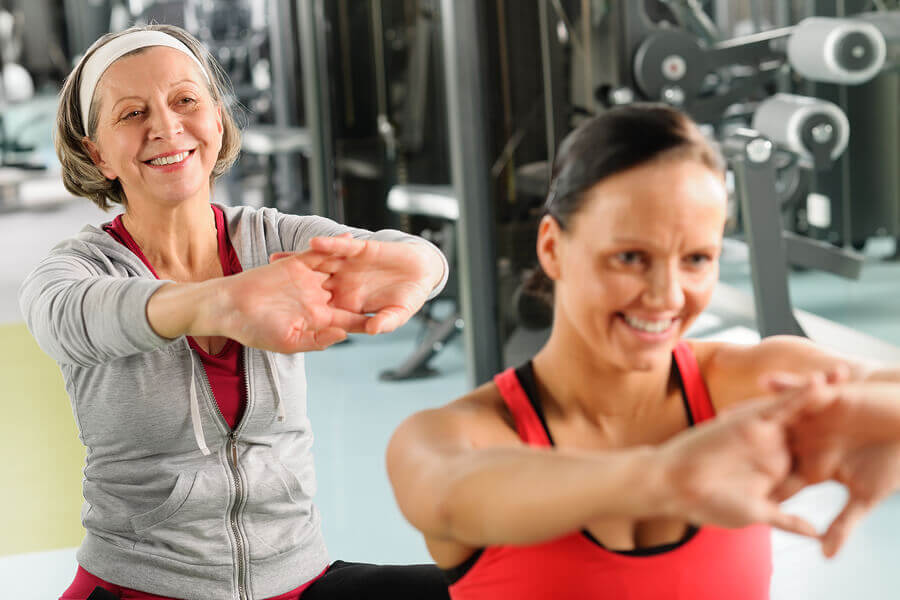Aging and Exercise: How are they Related?

Every physical activity carries consequences that can be positive or negative. For example, regularly exercising can lead to biological, genetic and physical changes that can have an impact on aging.
Those changes can take place not only internally, but externally as well. Whether they affect the eyes, skin, nails or mood, the changes are actually noticeable.
On the other hand, internal changes can include skeletal-muscle improvements, cardio-circulatory, and respiratory aspects, mental health and more. In today’s post, learn more about the link between aging and exercise.
Exercise, habits and eternal youth
Exercise changes the body in different ways. But it’s not the only ingredient for being healthy.
Physical exercise needs to go hand-in-hand with other fundamental aspects in order to slow down the aging process:
- Sufficient sleep.
- Proper nutrition that meets the recommendation of a nutritionist.
- Optimized workouts.
Sleep hours
Why is sleep so important? It’s simple: in certain phases of the sleep cycle, the human body carries out many processes to recover from the day. The phase is called the rapid eye movement sleep or REM sleep.

During REM sleep, the body repairs its nervous system and saves energy, which it uses non-stop during the day. The body also secretes anabolic hormones and increases protein synthesis, which helps repair muscle damage.
Proper nutrition plays a crucial role in aging and exercise
You need to supply your body with the fuel it needs in order to maintain a good balance of nutrients for your daily activities and workouts.
Following a good diet also implies avoiding toxic substances that can cause premature aging. Whether you exercise or not, they affect you with their high levels of harmful substances such as carbon monoxide, in the case of tobacco or alcohol use.
Furthermore, be careful about free radicals. Free radicals break down the body and cause problems such as:
- Aging.
- DNA alterations.
- Cardiovascular diseases.
- Arteriosclerosis.
- Diabetes.
- High levels of bad cholesterol.
- Cancer.
Optimized workouts
The intensity, duration, rest periods, weights and reps are all important aspects to consider when working out. If you adjust these factors optimally, they won’t just help you to progress in your fitness goals, but slow down aging as well.
Perfected workouts are precisely why many athletes show a lower biological age than their chronological age in bioimpedance tests. In other words, they look younger than they actually are.

Many interesting studies applied elderly subjects with exercise and everyday activities. In advanced ages, it’s common to experience a sedentary lifestyle. Consequently, the person suffers growing limitations on their physical capacity.
Aging and exercise: a double-edged sword
We’ve gone over the beneficial ways to slow down aging but… what happens if a person exercises incorrectly? Let’s look at a couple of examples of how something as healthy as exercise can become harmful:
- Excessively demanding sports or workouts: great examples include marathons or triathlons. Researchers have discovered that such practices cause a reduction in brain mass, a considerable decrease in testosterone levels, excessive oxidation and even kidney damage. These consequences don’t just affect a person’s appearance but internal health as well.
- High-intensity and short-interval sports with dependence on illegal substances: it’s the darker side of fitness. Training with heavier weights can boast great health benefits but not if they’re backed with anabolic-androgenic steroid use. This combination can actually create serious problems or even premature death.
The key rests with you
The decision rests on each individual. Is it better to follow healthy exercise and lifestyle habits that might limit certain intensities for maximum benefits? Or is it better to push harder and tiptoe the line that separates health and physical harm?
You only have one body…take care of it! This Canadian NGO, The Heart and Stroke Foundation, does a great job explaining the importance of aging and exercise. Everyone should strive to make healthy choices every day.
Every physical activity carries consequences that can be positive or negative. For example, regularly exercising can lead to biological, genetic and physical changes that can have an impact on aging.
Those changes can take place not only internally, but externally as well. Whether they affect the eyes, skin, nails or mood, the changes are actually noticeable.
On the other hand, internal changes can include skeletal-muscle improvements, cardio-circulatory, and respiratory aspects, mental health and more. In today’s post, learn more about the link between aging and exercise.
Exercise, habits and eternal youth
Exercise changes the body in different ways. But it’s not the only ingredient for being healthy.
Physical exercise needs to go hand-in-hand with other fundamental aspects in order to slow down the aging process:
- Sufficient sleep.
- Proper nutrition that meets the recommendation of a nutritionist.
- Optimized workouts.
Sleep hours
Why is sleep so important? It’s simple: in certain phases of the sleep cycle, the human body carries out many processes to recover from the day. The phase is called the rapid eye movement sleep or REM sleep.

During REM sleep, the body repairs its nervous system and saves energy, which it uses non-stop during the day. The body also secretes anabolic hormones and increases protein synthesis, which helps repair muscle damage.
Proper nutrition plays a crucial role in aging and exercise
You need to supply your body with the fuel it needs in order to maintain a good balance of nutrients for your daily activities and workouts.
Following a good diet also implies avoiding toxic substances that can cause premature aging. Whether you exercise or not, they affect you with their high levels of harmful substances such as carbon monoxide, in the case of tobacco or alcohol use.
Furthermore, be careful about free radicals. Free radicals break down the body and cause problems such as:
- Aging.
- DNA alterations.
- Cardiovascular diseases.
- Arteriosclerosis.
- Diabetes.
- High levels of bad cholesterol.
- Cancer.
Optimized workouts
The intensity, duration, rest periods, weights and reps are all important aspects to consider when working out. If you adjust these factors optimally, they won’t just help you to progress in your fitness goals, but slow down aging as well.
Perfected workouts are precisely why many athletes show a lower biological age than their chronological age in bioimpedance tests. In other words, they look younger than they actually are.

Many interesting studies applied elderly subjects with exercise and everyday activities. In advanced ages, it’s common to experience a sedentary lifestyle. Consequently, the person suffers growing limitations on their physical capacity.
Aging and exercise: a double-edged sword
We’ve gone over the beneficial ways to slow down aging but… what happens if a person exercises incorrectly? Let’s look at a couple of examples of how something as healthy as exercise can become harmful:
- Excessively demanding sports or workouts: great examples include marathons or triathlons. Researchers have discovered that such practices cause a reduction in brain mass, a considerable decrease in testosterone levels, excessive oxidation and even kidney damage. These consequences don’t just affect a person’s appearance but internal health as well.
- High-intensity and short-interval sports with dependence on illegal substances: it’s the darker side of fitness. Training with heavier weights can boast great health benefits but not if they’re backed with anabolic-androgenic steroid use. This combination can actually create serious problems or even premature death.
The key rests with you
The decision rests on each individual. Is it better to follow healthy exercise and lifestyle habits that might limit certain intensities for maximum benefits? Or is it better to push harder and tiptoe the line that separates health and physical harm?
You only have one body…take care of it! This Canadian NGO, The Heart and Stroke Foundation, does a great job explaining the importance of aging and exercise. Everyone should strive to make healthy choices every day.
All cited sources were thoroughly reviewed by our team to ensure their quality, reliability, currency, and validity. The bibliography of this article was considered reliable and of academic or scientific accuracy.
- Pardo, G. Consideraciones generales sobre algunas de las teorías del envejecimiento. Universidad de Camagüey.
- Ruiz L. Tollonosa P. Fisiología del envejecimiento muscular. Medicine, 1999, 7 (128).
- Mazzeo R. y colaboradores. 1998. El ejercicio y la actividad física en adultos mayores. Medicine & Science in Sports & Excercise. Vol 30 (6) 1998.
- Kane. R. (1999) Geriatrica Clínica. Nueva York. Mcgraw Hill. Inc.
This text is provided for informational purposes only and does not replace consultation with a professional. If in doubt, consult your specialist.








